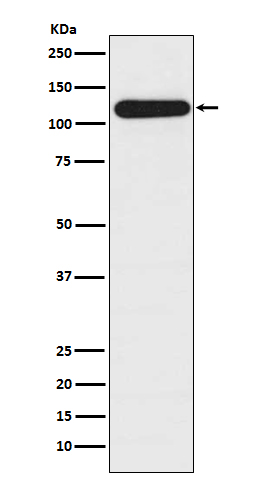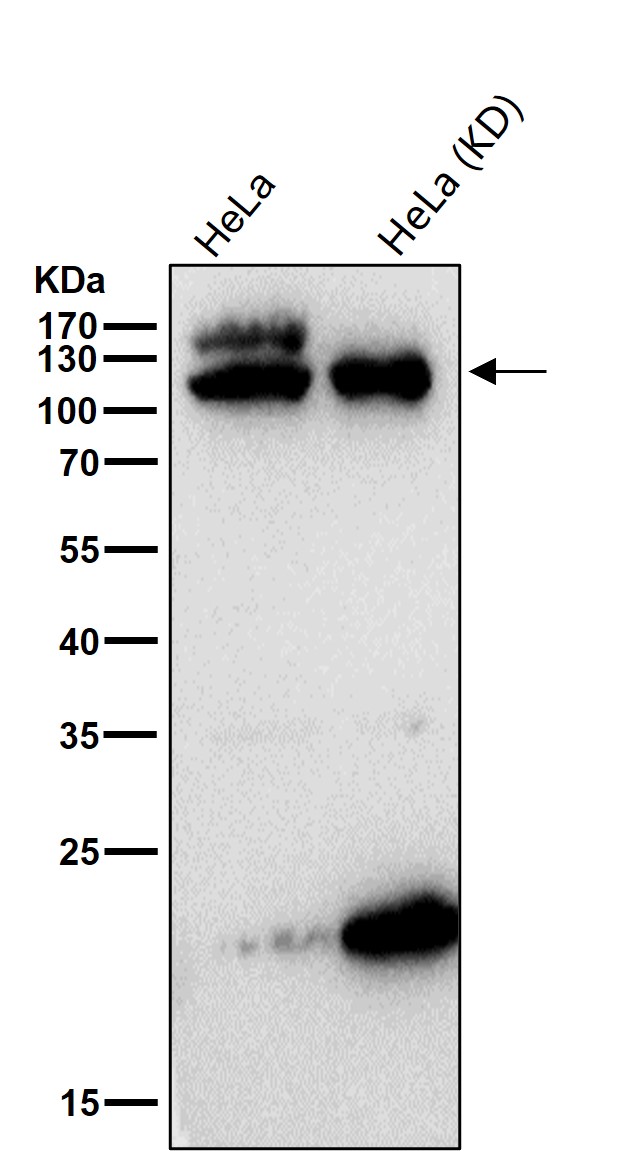

| WB | 咨询技术 | Human,Mouse,Rat |
| IF | 1/20-1/50 | Human,Mouse,Rat |
| IHC | 1/100-1/200 | Human,Mouse,Rat |
| ICC | 技术咨询 | Human,Mouse,Rat |
| FCM | 1/20-1/100 | Human,Mouse,Rat |
| Elisa | 咨询技术 | Human,Mouse,Rat |
| Aliases | hBUBR1; Mitotic checkpoint kinase MAD3L Protein SSK1; BUB1B; BUBR1; MAD3L; SSK1;;BUB1B |
| WB Predicted band size | 120 kDa |
| Host/Isotype | Rabbit IgG |
| Antibody Type | Primary antibody |
| Storage | Store at 4°C short term. Aliquot and store at -20°C long term. Avoid freeze/thaw cycles. |
| Species Reactivity | Human,Mouse,Rat |
| Immunogen | A synthesized peptide derived from human BUB1B |
| Formulation | Purified antibody in PBS with 0.05% sodium azide,0.05% BSA and 50% glycerol. |
+ +
以下是3-4篇关于BubR1抗体的代表性文献(信息基于公开研究整理):
---
1. **文献名称**:*"BubR1 is essential for kinetochore localization of other spindle checkpoint proteins"*
**作者**:Lampson MA, Kapoor TM
**摘要**:该研究通过使用BubR1抗体进行免疫荧光染色,发现BubR1对有丝分裂检查点蛋白(如Mad2和CENP-E)在动粒上的定位至关重要,揭示了其在染色体正确排列中的核心作用。
---
2. **文献名称**:*"Reduced expression of BubR1 protects against age-related aneuploidy and extends lifespan"*
**作者**:Baker DJ, et al.
**摘要**:利用BubR1抗体检测小鼠组织中BubR1的蛋白水平,发现其表达随年龄下降,且BubR1缺失导致染色体不稳定和早衰,补充BubR1可延缓衰老表型。
---
3. **文献名称**:*"Bub1 and BubR1: kinases involved in chromosome congression"*
**作者**:Elowe S
**摘要**:通过抗体介导的BubR1功能抑制实验,证明BubR1激酶活性对染色体在中期板上的正确排列至关重要,并参与调控细胞周期停滞。
---
4. **文献名称**:*"Deregulated BubR1 signaling induces premature aging phenotypes"*
**作者**:Kops GJ, et al.
**摘要**:研究采用BubR1特异性抗体分析其在肿瘤和衰老模型中的表达变化,发现BubR1表达异常与癌症进展及组织退化密切相关。
---
如需具体文献来源,建议通过PubMed或Google Scholar搜索标题及作者获取全文。
The BubR1 antibody is a crucial tool in studying the BubR1 protein (also known as BUB1B), a key component of the spindle assembly checkpoint (SAC), a surveillance mechanism that ensures accurate chromosome segregation during mitosis. BubR1 plays a vital role in monitoring kinetochore-microtubule attachments and delaying anaphase until all chromosomes are properly aligned. Dysregulation of BubR1 is linked to mitotic errors, aneuploidy, and diseases such as cancer or developmental disorders like mosaic variegated aneuploidy syndrome.
BubR1 antibodies are widely used in research to detect and quantify BubR1 protein levels, assess its localization via immunofluorescence, and investigate its interactions with other SAC components (e.g., Mad2. Cdc20) or regulatory kinases. These antibodies are essential for exploring BubR1's roles in cell cycle regulation, aging (reduced BubR1 correlates with age-related pathologies), and cancer biology (overexpression or mutations in tumors).
Commercial BubR1 antibodies are typically developed in hosts like mice or rabbits, targeting specific epitopes (e.g., N-terminal or kinase domains). Validation includes Western blotting, immunoprecipitation, and knockout cell line controls. Challenges include cross-reactivity with related kinases (e.g., BUB1) or detecting splice variants. Recent studies also highlight BubR1's potential as a therapeutic target or biomarker in cancers with chromosomal instability. Its study continues to shed light on mitosis, genome integrity, and disease mechanisms.
×